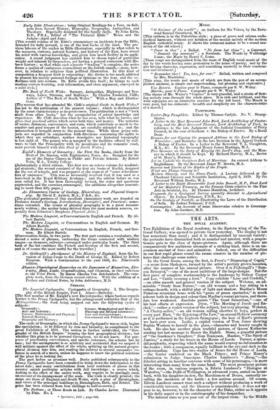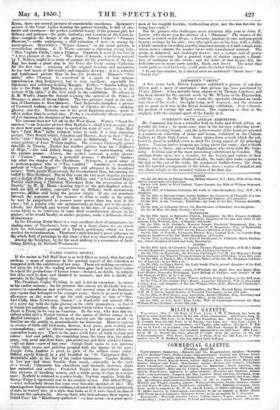THE ARTS.
THE• ROYAL ACADEMY,
THE RAI:aim of the Royal Academy, in the Eastern wing -of the We- -Send Gallery, was opened to private view yesterday. The display is not less numerous than usual ; and it is distinguished by unusual variety : -the portsaits have diminished both in number and intes eat, -with a propor- tionate gain to the -class of figure-pictures. Again, although there are comparatively few ambitions attempts of a striking kind, there is an tin- -common amount -of force and animation. Indeed, one of the difficulties in -our first rapid glance round the rooms consists in the number of pic- tures that challenge some notice. In the Great Room, among the first, is Frost's "Disarming of Cupid," —a scene from Shakapere, formed by the artist's prettily grown beauties, after the manner of his annual picture. Over it is Piekersgill's "Sam- son Betrayed,"---one of the most ambitious of the large designs. But the first piece of complete workmanship is the landscape by Sidney Cooper and Lee, "Cattle crossing a ford." Cope exhibits "Lear and Cordelie.," —an ultra smooth and genteel version of the 'subject. Webster, an ad- mirable "Study from Nature,"—an old woman and a boy sitting in siottago-hearth, with a skilful play Of light and shadow. Maeliso's; Mosee Primrose returning home with his "gross of green spectacles," is much soberer both in design and colour than Maelises recent pictures, and there. fore less weakened. Eastlake paints "The -Good Samaritan,"—one of his best efforts at expression. Dyce, "The Meeting of Jacob and Ra- ehel,"—rather a realist version of -the subject, but veryploasing. Webster, "A Cherry-seller,"—en old woman selling cherries to boy; perfect in every part. Hart, "the Rejoicing of the Law;" an annual Hebrew ceremony as it is performed in the Leghorn Synagogue; the best of East's pictures we have ever seen. • Leslie, a capital version of Tom Jones showing Sophia Western to herself hi the glass,--character and beauty caught in both. He also has another plain truthful picture, of Queen Katharine sending her last message to Henry the Eighth. Stone, a graceful picture of ."the Gardener's Daughter," from Tennyson. Mediae, "The Spirit of -Justice," a doily for his fresco in the House of Lords. Turner, a splen- did perplexity, respecting which the name would convey no information to the reader ; with a companion, equally brilliant to the eye and dark to the understanding. Cope has two studies of fresco for the House of Lords, —the Garter conferred on the Tilaelr Prince • and Prince Henry's submission to Judge Gascoigne. Charles Larseer's " 2Esop,.' —the fabulist sitting in familiar converse with some of his personages,—is more interesting than many from the same hand. The most prominent picture of the room, in various respects, is Edwin Landseef a "Dialogue at Waterloa,"—the Dun of Wellington, in advanced years, seated on horse- back; with his daughter-in-law, the Marchioness of Douro, earnestly re- calling the incidents of the battle : a few natives around. Of course, Edwin Landseer cannot treat such a subject without producing a work of considerable interest, and the likeness is unmistakeable : it does not ap- pear to us, however, to hit the character of the Duke, either as it appears in his -daily aspect or in the autobiography of his despatches. The -interest rises as you pass out of the largest room. lathe Middle .Room, there are several pictures of considerable excellence. Redgraves picture of the Court Ladies dressing the patient Griselda, is full of cha- racter and sweetness : the perfect youthful beauty of the peasant girl, her delicacy and patience—the pride curiosity, and vexation of the Court la- dies—complete the design of the picture. Sidney Cooper's "Summer _Showers "—rattle undergoing a chill viaitation of wet,—is among his masterpieces. Branwhite's " Winter Sunset," on his usual pattern is nevertheless striking. G. F. Watts converts a charming young lady, "Kim Virginia Pattle,"”inta.a Titaness. Crosaiek is seen at his best in "A first glimpse of the Sea." The Duke d'Aumale, a striking portrait by V. Matter, might be a study of costume for the gentlemen of the day. has- made -a great step in his Peter the Great seeing Catherine for the first time : retainina all his Original freedom and animation, he has lost-much of his Crudity and ungainly drawing ; it is a robuster and handsomer picture Than he has yet produced. Ehnore's "Gil-
ielde," after Chaucer, is conceived in a spirit of leas delicate • prehension than liedgrave'a, hat is very , excellent; especially the handsome and arbitrary-keldnit Menials. Frith's " Sancho telling his tale to The Ditke and Dint** to prove that Don Quixote is at the bottom'ef tic table,' isthe best story in the exhibition. No offence to
.E. L W Jatilealhe Sarnia 'learning the arrival-of the Prince of Orange;---a piece of IttiagMlitkay.' The two pictures stand in the Tell- lien of.Clarmulon.to aDon4aixote. Paul Trelaroche furnishes a picture of Cromwell- looking-mtithe -dead body of Charles the First,—striking, gloomy, and dry. Roberts, one of his great Egyptian menea—great in elfeat,rrathar think rn.actualaaare, Poole,-a erimatically effective picture cifJob loaruhagahe slaughter of Ma servants.
The interest does-not fall' air inthe -West Room. Watts's "Good Sa- maritan "a-atin honester pieturn-thast Eastlake's=ehall teach us some day to show treargood prerparreaday be spoiled' for Went of work. John Mar- tins "!0t Maii"" k4Ith CiatemOn sense to -make it a very imposing pictare.ITWO Seller-ton and Harvey, show in their " Ilay- teldr7&i4 ?...‘ iiiiN4.6.4" that life is astir in Edinburgh. Ward has a
of 'ISaac Waltçm angling., The younger Pickersgill grows
, m. Titania. -,bas- another picture from his "Fallacies of kope,'-',--,4-the saiii:`fallacy being, any hope of understanding what the pietare means.: !datum the perfect contrast, a noble picture of "Neulee." Armitage,- a, powerful picture, " Atiolibah " hanker- ing _after thelintagem'ofethei-,Chaldeans. Solomons a good satire of * Iparitraitapairater, Who' 'ilirelieTtro truthful." Landseer, a wonderful pertridii-aif 3dgoodfillbrgi56.", 'Bedgrave still advances in his woodland steirehr-' it' 'fitli"Ronfiyvrood; the Goednathred Man, introducing the
lartilffiVo . in this Mom the two most singular pictures
are; 3kFarell I j6C893, 1,41-aisand " A -Converted British
Missiouary from the persecution of the
Druids;',, " 4aleading types of the preaRaphael school : both ars ::19 especially that by Millais;:-:both monstrously perversepAillais still being the greater culprit. If one can penetrate through tke„tierfsense.,ef thp manner to what is really in the artist, he mity.he. ,mi9ctuted to possess more power than any man in the
place: hilt a who can spontaneously go back, not to the perfect sdhocils, but ug "..tuid beyond them to the days of puerile crudity, seems likely to be '&itiscious of sonic fatal constitutional disease in his genius; -or he would hardly, in malice prepense, make a deliberate choice of impotency.
In the Drawing Rodrhithere is a very excellent show of miniatures, in- cluding some of Thorburn's best ; and at a hasty glance we are struck with the full-length portrait of a French gentleman, which we have marked for reeximilmatiolIK Thorburn's style has had a great influence on the whole "4.44 of paintings in this class; a fact very-observable this -year.
Among Alie Sculpture, by far the most stilling is a monument of Arch- bishop HOWley, by Richard Westmacott.

























 Previous page
Previous page